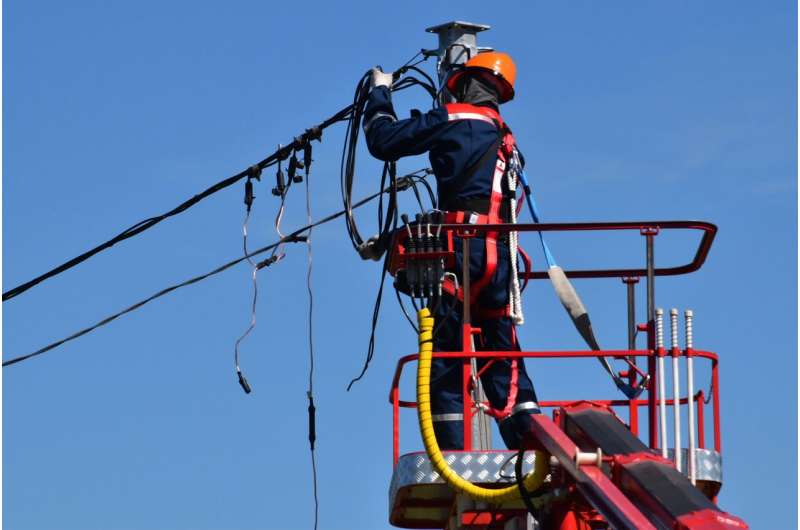This article has been reviewed according to Science X's editorial process and policies. Editors have highlighted the following attributes while ensuring the content's credibility:
fact-checked
peer-reviewed publication
trusted source
proofread
Some communities are more vulnerable to weather-related power outages in New York State

Weather-related power outages in the United States have become nearly twice as common in the last 10 years compared to the previous decade. These outages, which can last most of a day, are more than an inconvenience: lack of power and related indoor temperature discomfort can exacerbate health conditions; lack of power also endangers the lives of people who are reliant on electricity-powered medical devices and/or elevators.
A study led environmental health scientists at Columbia University Mailman School of Public Health and the University of Washington examines the link between various types of extreme weather and outages in New York State between 2017 and 2020 and who is most at risk in both urban and rural settings.
They find that certain regions, including eastern Queens, upper Manhattan and the Bronx, the Hudson Valley, and Adirondack regions were more burdened with severe weather-driven outages (see a list of the most impacted areas below).
The study in the journal PLOS Climate is among the first to provide a granular understanding of severe weather-driven outages and their community impacts.
"The vulnerability of the power grid to severe weather events is a critical issue as climate change is expected to increase extreme events, which can damage components of the power grid and lead to power outages," says study first author Nina M. Flores, a doctoral student at Columbia Mailman School.
"Understanding what communities are most affected by these outages can help policymakers shore up the electrical system and prepare contingency plans."
In their study, Flores and colleagues paired hourly power outage data in 1,865 electrical power operating localities throughout New York State with CDC Social Vulnerability Index, and hourly weather data from 2017 through 2020. They found that 40% of all outages co-occurred with severe weather. Dual extreme heat/precipitation and extreme precipitation/wind were the most likely to precede outages while extreme precipitation/wind and extreme wind alone led to the longest outage durations.
The average duration of outages in rural regions was 12.5 hours compared to 18.5 hours in cities other than New York City and 20.2 hours in the New York City area.
In New York City, heat-, precipitation-, and wind-driven outages disproportionately impacted vulnerable communities; on average, the duration of precipitation-driven outages was highest in neighborhoods with the highest social vulnerability. Likewise, in rural New York State, on average, the duration of precipitation- and snow-driven outages were higher in localities with higher social vulnerability.
The most impacted New York locales by type and the total number outage events driven by severe weather, 2017–2020:
- New York City neighborhoods: Jamaica (Queens), 147; Flushing (Queens), 138; Richmond Hills (Queens), 104; Woodrow (Staten Island), 98; Wainwright (Staten Island), 94.
- Cities other than New York City: Lewisboro (Westchester), 48; Flower Hill (Nassau), 42; Putnam Valley (Putnam), 39; Boston (Erie), 38; Cornwall (Orange), 38.
- Rural New York: Mill Neck (Nassau), 30; Long Lake (Hamilton), 29; Morehouse (Hamilton), 29; North Salem (Westchester), 28; Pound Ridge (Westchester), 28.
Ensuring uninterrupted electricity will take a variety of policy changes. For example, the researchers write that New York City may prioritize improvements that increase reliability during extreme precipitation, as extreme precipitation-driven outages were both more frequent and longer in vulnerable regions.
Programs to subsidize cleaner and safer solar-powered battery backup power sources are also needed—especially for people who depend on electricity for medical reasons. (Gas-powered backup generators put people at risk of carbon monoxide poisoning.)
Senior author Joan A. Casey, assistant professor of environmental and occupational health sciences at the University of Washington, says, "Climate change necessitates that we address power outages. In addition, our transition to clean energy will slow climate change but make more people reliant on electricity for heating, cooking, and transit.
"We should be mindful that this can increase the number of individuals vulnerable to adverse health impacts due to power loss, and also further burden vulnerable communities that our study already identified. Moving forward equitably will require targeted improvements in these regions."
More information: Powerless in the storm: severe weather-driven power outages in New York State, 2017-2020, PLOS Climate (2024). DOI: 10.1371/journal.pclm.0000364
Journal information: PLOS Climate




















